In the digital age, user interface (UI) and user experience (UX) design have become crucial components of our interaction with technology. However, there is an unsettling trend in the corporate world: UI/UX design is deteriorating. This decline is not due to a lack of talent or technological advancements, but rather a shift in corporate priorities driven by shareholder interests. Despite this bleak scenario, companies like Nothing and The Browser Company are emerging as beacons of hope, demonstrating that superior UI/UX design can still fun and nice to use without sacrificing functionality or losing shareholder value.
The Corporate Neglect of UI/UX Design
Large corporations have increasingly deprioritized UI/UX design. The primary reason lies in the relentless pursuit of shareholder value. In a landscape where quarterly earnings reports dictate decisions, long-term investments in quality design often fall by the wayside. Shareholders, focused on immediate returns, rarely prioritize the nuanced and often invisible benefits of good design. As a result, companies cut corners, leading to products that are less intuitive and more frustrating for users.
Symptoms of the Decline
Several symptoms indicate the worsening state of UI/UX in corporate products:
-
Overcomplicated Interfaces: Many applications and websites are cluttered with unnecessary features. This complexity makes navigation difficult, diminishing the user experience.
-
Inconsistent Design: Corporations frequently roll out updates that alter the look and feel of their products without maintaining consistency, confusing users and disrupting their routines.
-
Ignoring User Feedback: Despite having access to vast amounts of user data and feedback, corporations often disregard this information, opting for decisions that favor short-term gains over user satisfaction.
Shareholder Influence
The influence of shareholders on corporate strategy cannot be overstated. They wield significant power, and their focus on financial metrics over customer experience drives companies to prioritize profits above all else. This myopic view undermines the importance of UI/UX design, which, while not directly tied to immediate financial outcomes, plays a critical role in long-term user retention and brand loyalty.
The Bright Spots: Nothing and The Browser Company
In stark contrast to the corporate giants, companies like Nothing and The Browser Company are revitalizing the emphasis on UI/UX design.
Nothing
Founded by Carl Pei, Nothing is on a mission to bring artistry and human-centered design back to technology. Their products, such as the Nothing Phone, are praised for their minimalist design and intuitive interfaces. Nothing’s approach is a refreshing departure from the cluttered and convoluted designs prevalent in the industry. By focusing on simplicity and user experience, Nothing demonstrates that it is possible to prioritize design without sacrificing functionality.

The Browser Company
The Browser Company, creators of the Arc browser, are also making waves with their innovative approach to UI/UX. Arc reimagines the web browsing experience by prioritizing user-centric design principles. Its interface is clean, intuitive, and highly customizable, setting a new standard for how web browsers can look and function. The Browser Company’s commitment to design excellence shows that a focus on UI/UX can lead to groundbreaking products that stand out in a crowded market.

Conclusion
The decline in corporate UI/UX design is a concerning trend driven by the relentless pursuit of shareholder value. However, the emergence of companies like Nothing and The Browser Company offers a glimmer of hope. These innovators are proving that it is possible to prioritize exceptional design while still achieving commercial success. As more companies recognize the long-term value of investing in UI/UX, we can hope for a future where user-centered design once again takes center stage in the technology industry.
By acknowledging the current shortcomings and celebrating those who are leading the change, we can advocate for a renewed focus on UI/UX design that enhances our interaction with technology and enriches our digital lives.

